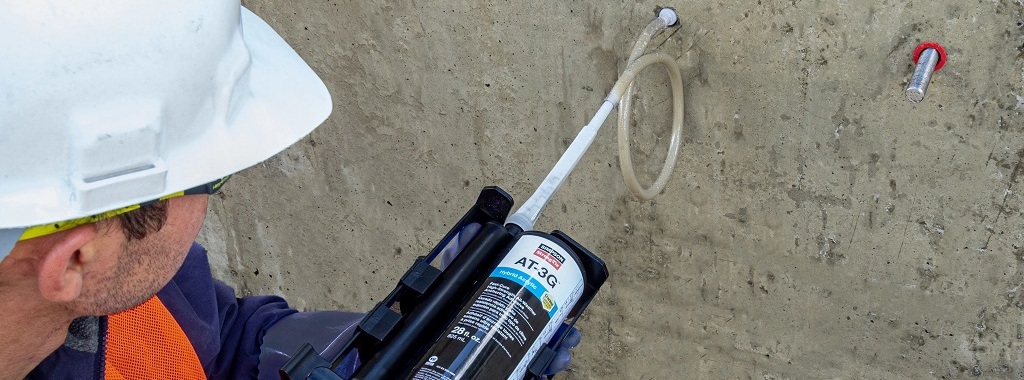In general, post–installed adhesive anchor design per ACI 318 Chapter 17 is relatively straightforward. In practice, however, post–installed anchorage can often become challenging because of fast–track project schedules, supply issues, ever-changing weather conditions, design conflicts/changes, or unexpected field conditions.
Simpson Strong-Tie’s third–generation (3G) family of adhesive solutions (see Figure 1), consisting of SET-3G™, ET-3G™, and AT-3G™, rise to these challenges. This blog post discusses important structural engineering design properties in AT-3G hybrid–acrylic anchoring adhesive that ensure its reliable and effective performance in different applications. It concludes with helpful concrete anchorage design and support resources.
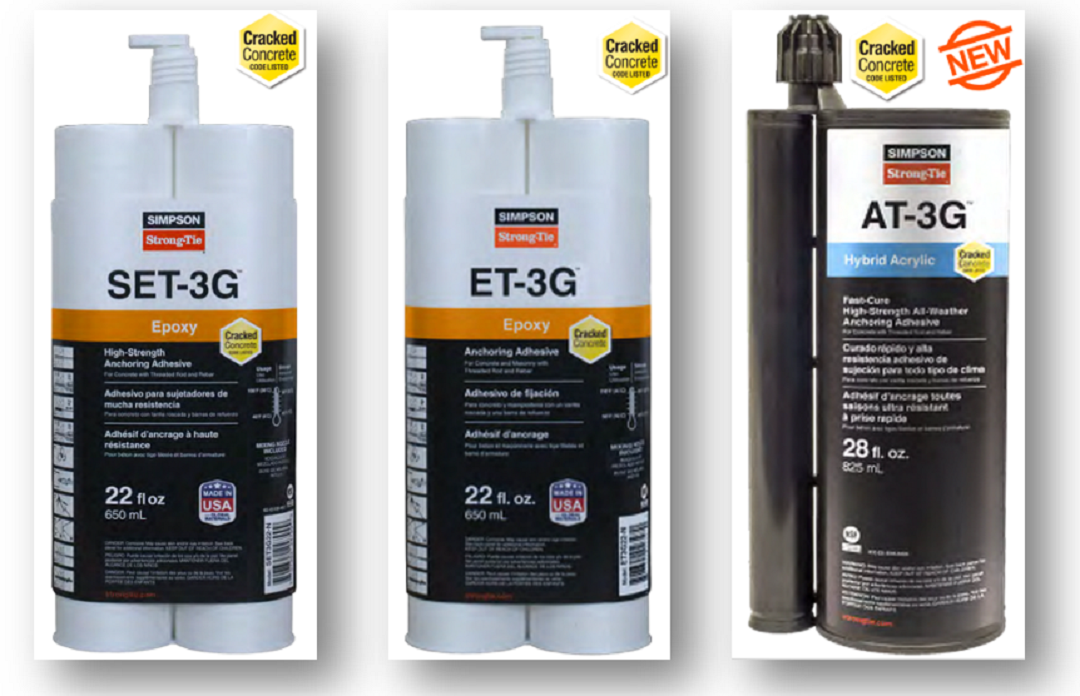
AT-3G replaces Simpson Strong-Tie’s acrylic adhesive solution, AT-XP. Why did we introduce a new acrylic-based anchoring adhesive, you may wonder. Because the AT-3G formulation has better overall performance. Compared to AT-XP, AT-3G has superior design bond strengths in both threaded rod and rebar applications, has improved performance in water-saturated concrete, permits installation in water-filled holes, and cures faster at ambient temperatures.
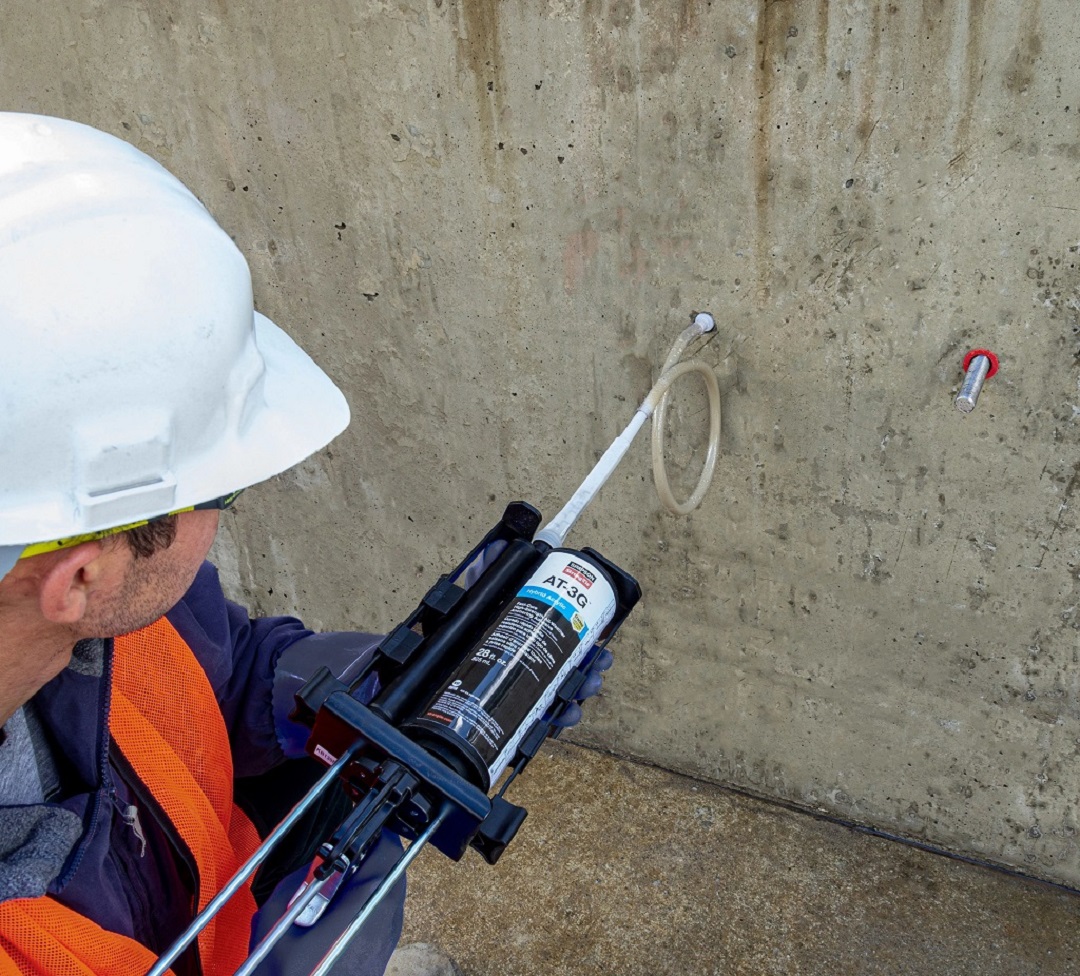
Remind me again, what exactly is a hybrid acrylic?
AT-3G is an injectable two-component, hybrid acrylic-based adhesive. A labeled, dual-cylinder cartridge (both coaxial and side-by-side) keeps the two components separate prior to use. The components combine and react when dispensed through a static mixing nozzle, which comes attached to the cartridge packaging. At a chemical level, AT-3G hybrid acrylic has a 10:1 ratio of resin to initiator, whereas SET-3G and ET-3G are both epoxy based using a 1:1 ratio of resin to hardener. Ultimately, the main differences between hybrid acrylic– and epoxy-based adhesive anchoring systems are the gel and cure times. Acrylics have shorter gel and cure times. Think of gel time as the working time — in other words, the time the installer has to place the adhesive into the drilled and cleaned hole and then insert the threaded rod or rebar anchor before the adhesive begins to harden. Whereas cure time is the overall time required for the anchor to develop its ultimate load carrying capacity.
What makes AT-3G so different?
AT-3G has a higher heat deflection temperature, a reduced linear coefficient of shrinkage, and a higher glass transition temperature than the epoxy-based SET-3G and ET-3G products. Table 1 indicates the differing characteristic properties across the three anchoring adhesives. The heat deflection temperature, also known as the heat distortion temperature, is the temperature at which the adhesive begins to soften. Per ASTM D648 test method, AT-3G’s value is 258oF. When the adhesive cools back to room temperature, it hardens without any permanent physical changes. The glass transition temperature is a measure of the temperature at which certain properties do not return when the adhesive cools back down. This single temperature value encapsulates several mechanical strength, thermal, electrical, and resistance properties that occur over a range of temperatures. Per the ASTM E1640 test method, AT-3G’s value is 237oF. Note the glass transition temperature also depends on the in-place curing conditions. In general, the mechanical and chemical bond properties improve with longer adhesive cure times, potentially increasing the overall structural performance.
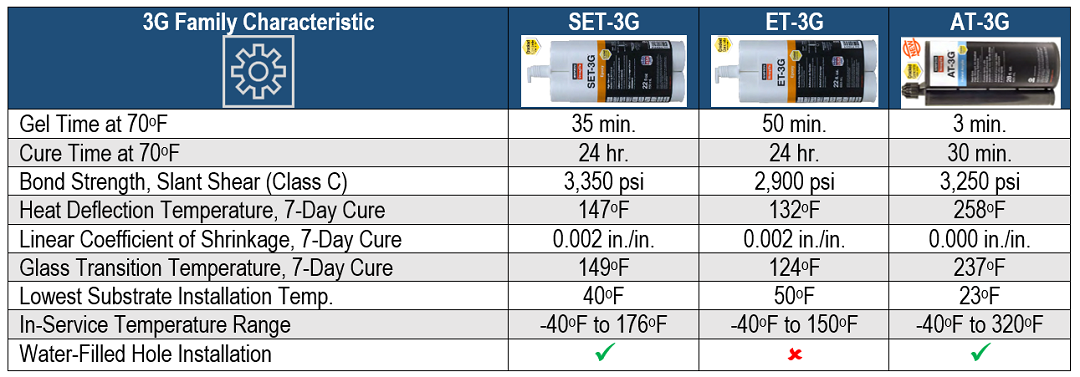
Ok, but what really makes AT-3G worth specifying?
AT-3G’s ICC-ES Evaluation Report for cracked and uncracked concrete, design flexibility, fast cure, and cold temperature installation application make it worth adding to your project specifications. AT-3G offers consistent bond-strength, slant shear values across all tested temperature range classes (Table 2). AT-3G has an average 14-day–cure concrete bond strength of 3,180 psi across a temperature range of 35o to > 60o.

AT-3G provides the ultimate in design flexibility since it accommodates dry, water-saturated, and water-filled hole installation and tolerates in-service temperature ranges from -40oF to 320oF. It cures faster at ambient temperature than traditional epoxy–based adhesives. This fast cure time achieves design strengths quickly and allows construction to continue uninterrupted. It allows for installation into concrete base materials as low as 23oF without affecting the design bond strength. Table 3 displays the AT-3G gel and cure times for varying concrete base material temperatures. Note that at 68oF and warmer, AT-3G’s cure time is 30 minutes.

That’s great, but what about all that code compliance stuff?
ACI: AT-3G was tested and evaluated per ACI 355.4 — Qualifications of Post-Installed Adhesive Anchors in Concrete and AC308 — Acceptance Criteria for Post-Installed Adhesive Anchors in Concrete Elements. AT-3G can be specified for threaded rod anchoring, rebar anchoring, post-installed rebar development, and splice length provision applications. The post-installed reinforcing bar system is an alternative to cast-in-place reinforcing bar connection governed by ACI 318 and IBC Chapter 19.
International Code Council Evaluation Service (ICC-ES): The ICC-ES evaluated AT-3G and released evaluation services report ESR-5026 for cracked and uncracked concrete applications in January 2023. AT-3G is compliant with the following building codes: 2021, 2018, 2015, 2012 and 2009 International Building
Code® (IBC) and International Residential Code® (IRC). Two ESR-5026 Supplements provide compliance with the 2023 City of Los Angeles Building Code (LABC), the 2023 City of Los Angeles Residential Code (LARC), the 2023 Florida Building Code (FBC) — Building, and the 2023 Florida Building Code (FBC) — Residential.
ASTM and AASHTO: AT-3G meets ASTM C881 and AASHTO M235 — Types I/IV and II/V, Grade 3, Class B & C.
NSF/ANSI: AT-3G complies with the requirements of NSF/ANSI Standard 61, as referenced in Section 605 of the 2021, 2018, 2015, 2012, and 2009 International Plumbing Code® (IPC) and is certified for use as an anchoring adhesive for installing threaded rods less than or equal to 1.3–inch diameter in concrete for water treatment applications.
This is great information! Do you have any design tools?
We certainly do, and they are all free! The Simpson Strong-Tie® Anchor Designer™ (Figure 2) desktop application completes real-time anchorage design in a fully interactive 3D graphic interface, supports imperial– and metric-sized Simpson Strong-Tie mechanical and adhesive anchors, and traditional cast-in-place or headed stud layouts. Anchor Designer calculates single– and multiple–anchor layouts (up to 16 anchors in a single base plate). It includes quick–start design templates, simplified or custom anchor placement tools, a base plate thickness calculator that uses FEM, and the multi–design anchor optimization tool, which determines the shallowest embedment depth with passing results, and displays it for each anchor model. Design results are dynamically displayed on screen and are available for printing.
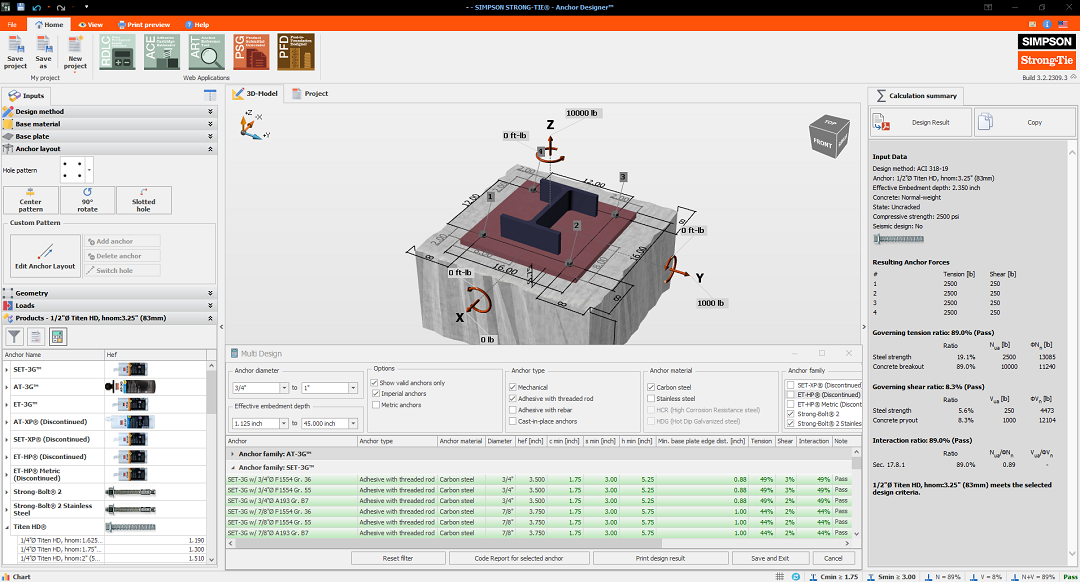
Next up is the Rebar Development Length Calculator (Figure 3), a web application that supports the design of post-installed rebar in normal–weight, sand-lightweight, and all-lightweight concrete base materials. It calculates the necessary tension and compression development lengths required in accordance with ACI 318-14/ACI 318-19 provisions. It also calculates Class A and Class B lap splice required development lengths.
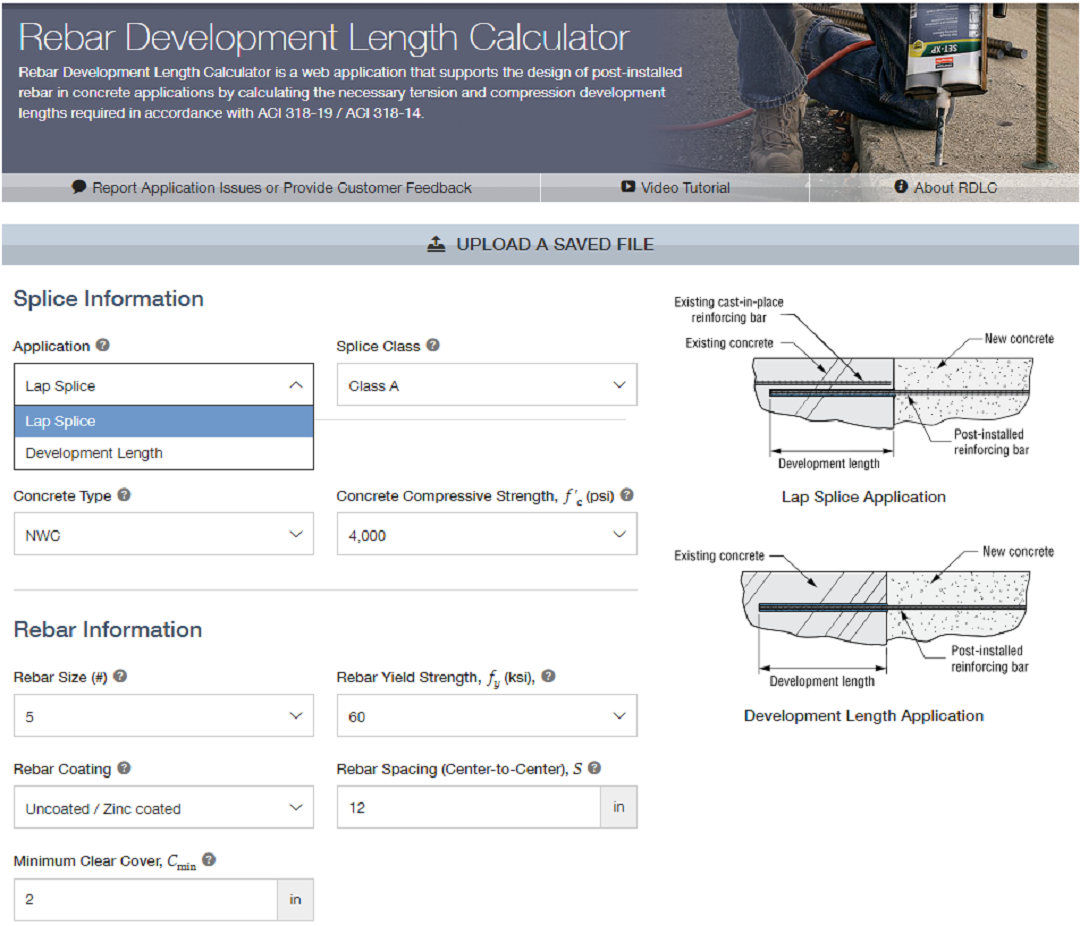
Lastly, for all three anchoring systems including AT-3G, strongtie.com provides code reports, engineering letters, technical bulletins, data sheets, installation videos, and drawing details (PDF DXF RFA). Figure 4 displays five of 13 literature results using the PDF Literature and Catalogs section available in the Resource Center by entering the keyword AT-3G. They include a technical data sheet and engineering letters.
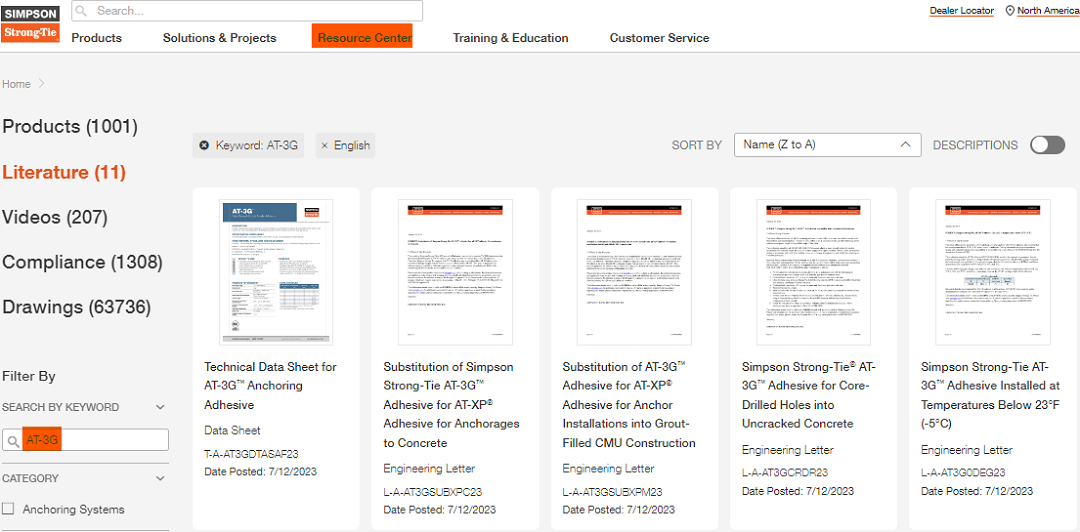
Anchor away!
In summary, there are important material properties in adhesive anchoring systems that ensure their reliability, load-carrying capacity, and effectiveness in project applications. AT-3G meets or exceeds industry-developed acceptance criteria in cracked and uncracked concrete. AT-3G is excellent for use in cold-weather conditions or applications where a fast cure is required. It allows for specification in a wide range of in-service temperatures, and maintains its strong bond strength in extreme environments. AT-3G comes with bond strength, design tools, and technical documentation for efficient design, specification, and installation on your next project. 3g

